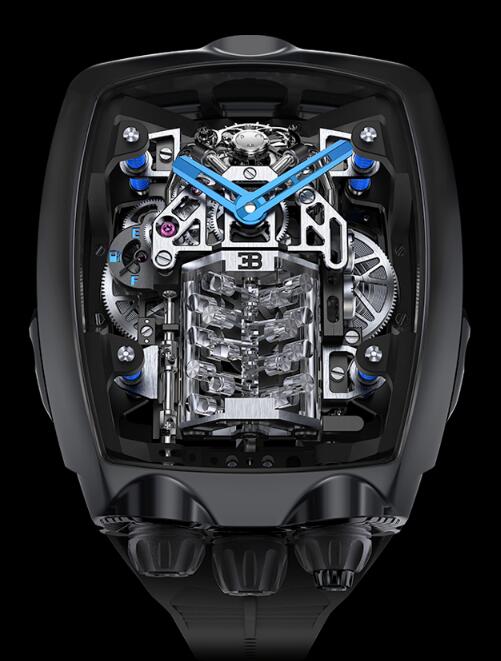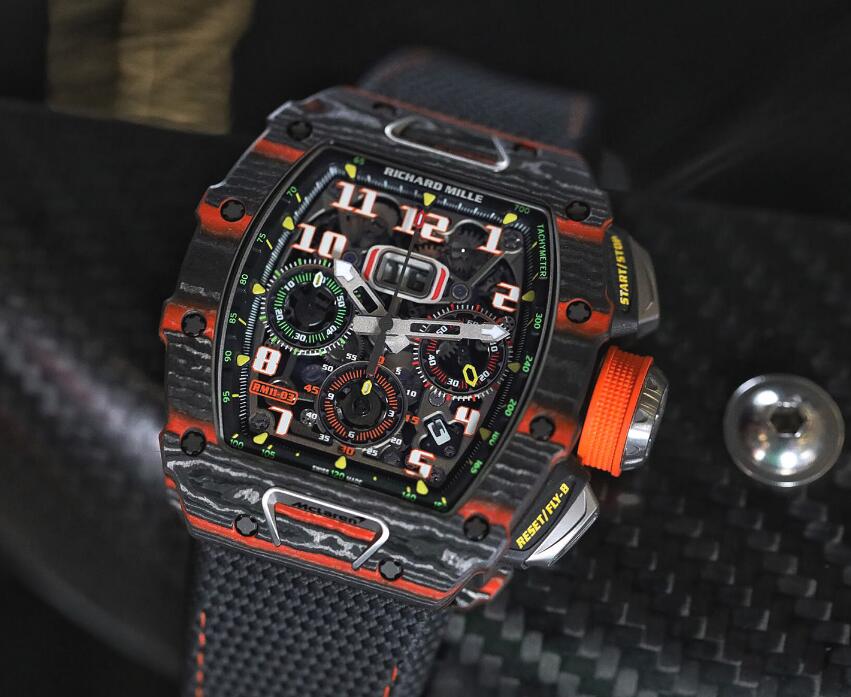
Exotic cars and beautifully handcrafted timepieces go together like salt and pepper. They just work. In many cases, watch manufacturers produce watches that fit exotic auto industry or even specific vehicles. Makes and Movements will select wonderful products through the DuPont Registry and pair them with current or pre-release watch replicas cheap. The diversity of vehicles and timepieces will reveal different brands and help to understand new areas of each industry.
Bugatti Chiron Tourbillon
The collaboration between Jacob & Co. and Bugatti began in 2019, with both industry leaders looking to embody the true spirit of both brands through a collection of never-before-seen luxury timepieces. The dynamic duo aimed to combine the luxury qualities of a supercar with the development of high-end timepieces to help bridge the gap between the two industries. Following the release of the iconic Bugatti Chiron chassis, the team at Jacob & Co. set out to design a collection dedicated to taking watchmaking to impossible heights. The Jacob & Co. Bugatti Chiron Tourbillion is the answer to this multi-million dollar supercar. The design styles of the Jacob & Co. Bugatti Chiron Tourbillon and Bugatti Chiron Pur Sport mimic each other on two different scales, and together they form the perfect performance-oriented partner.
The Jacob & Co. Bugatti Chiron Tourbillon continues to embody Bugatti’s vision and its journey to push the limits of performance, combining luxury design and state-of-the-art movement technology. The Bugatti Chiron Tourbillon is a 44mm super watch crafted from DLC-treated titanium, giving it a lightweight design that any collector can trust. The real beauty is revealed under the transparent sapphire crystal glass, and the redesigned skeleton dial layout represents the W16 engine platform developed by the Bugatti brand. A quick press of the right-hand crown activates the Jacob & Co. Bugatti Chiron Tourbillon’s crankshaft, which turns and operates 16 pistons to mimic the workings of an internal combustion engine. Powering the watch is Jacob & Co.’s in-house JCAM37 hand-wound movement, which features a “flying” tourbillon that allows you to get a closer look at the inner workings of the mechanism. The JCAM37 features a highly complex movement developed in-house that offers a power reserve of up to 60 hours, indicated by an air pump gauge on the dial. The see-through case back allows the wearer to get a closer look at Jacob & Co.’s craftsmanship and attention to detail. Jacob & Co. wanted it to be a practical everyday timepiece, outfitting the Bugatti Chiron Tourbillon with a comfortable black rubber strap and matching black DLC titanium deployant buckle.
why buy
When considering the Jacob & Co. Bugatti Chiron Tourbillon, “why buy” quickly becomes “why own”. The Bugatti Chiron Tourbillon is produced in limited quantities, exclusively for those who have a Bugatti key in their garage. The long heritage of Jacob & Co. and Bugatti marks a milestone for the Chiron Tourbillon as the two luxury giants, making it increasingly valuable in the secondary market. The Jacob & Co. Bugatti Chiron Tourbillon represents a bridge between two worlds, combining engine and watch.
Bugatti Chiron Pur Sport
While the EB110 and Veyron models started to generate hype around the Bugatti name, the French automaker represents more than a decade of design and engineering helping to compete at the highest level. The Chiron platform is helping the brand move towards a new generation of performance, and a more powerful version of the chassis is being developed behind the scenes at the Bugatti workshop in Molsheim, France. The Bugatti Chiron Pur Sport is a unique chassis with stunning performance specifications and only 60 examples will be offered to the brand’s most qualified customers. The definition of a supercar is a reminder that Bugatti is constantly striving to achieve more power and become a benchmark in the automotive industry. bugatti watch price
The Bugatti Chiron Pur Sport features lightweight exterior updates that add aggressive styling geared towards agility. The bodywork has been redesigned with a new front bumper, larger air intakes, a larger rear diffuser and a wider version of the iconic horseshoe grille. One of the most notable changes to the Chiron Pur Sport comes from the fixed rear spoiler, which has an X-shaped design to generate a lot of downforce at high speeds. At the heart of this beast is Bugatti’s famous 8.0-liter quad-turbocharged W16 engine, capable of producing more than 1,500 horsepower and 1,180 pound-feet of torque. The Bugatti Pur Sport is equipped with a 7-speed dual-clutch automatic transmission and accelerates from 0 to 60 mph in just 2.59 seconds. The track-inspired interior layout includes minimalist design, from the two-tone sports seats to the carbon fiber trim elements that help reduce weight while adding support. The interior of the Bugatti Chiron Pur Sport deliberately presents a raw and sporty ambience to accentuate its driver-oriented cockpit. As well as a new updated exterior and interior, the Chiron Pur Sport also gains updated technology features and driving dynamics modes to help connect drivers of any driving experience with the road. The Bugatti Chiron Pur Sport perfectly embodies the brand’s current moment in history, with plenty of power to pursue new top speeds.
why buy
The Bugatti Chiron Pur Sport is the best new addition to the garage, as the brand has a tradition of being pioneers in the supercar segment. Although only 60 were produced, the value of the Chiron Pur Sport will endure as it becomes one of the most popular models in Bugatti’s multi-million dollar fleet. For owners who want to stand out from the rest of the Chiron Pur Sport models available, Bugatti offers a one-of-a-kind configuration experience to help you realize your dreams. high quality watches replica

